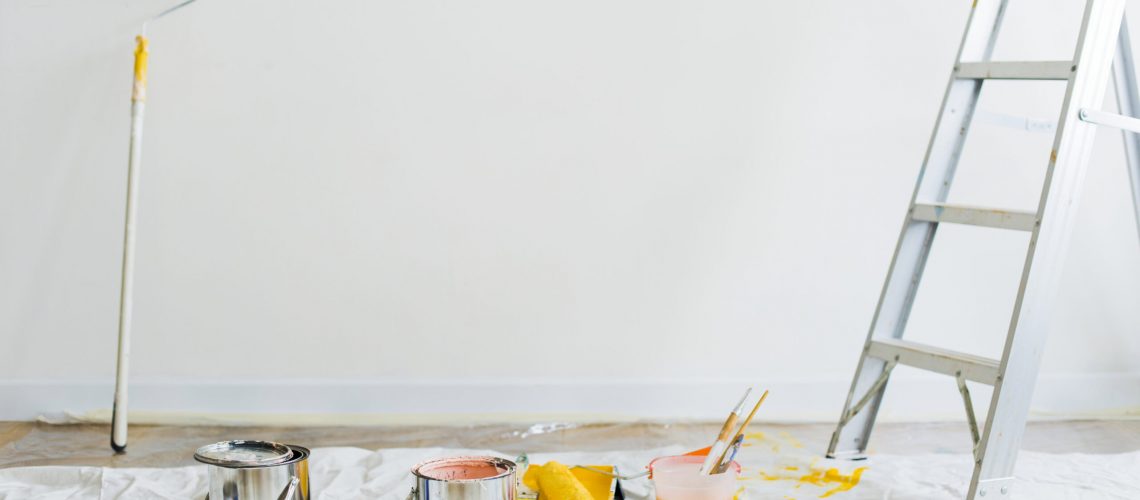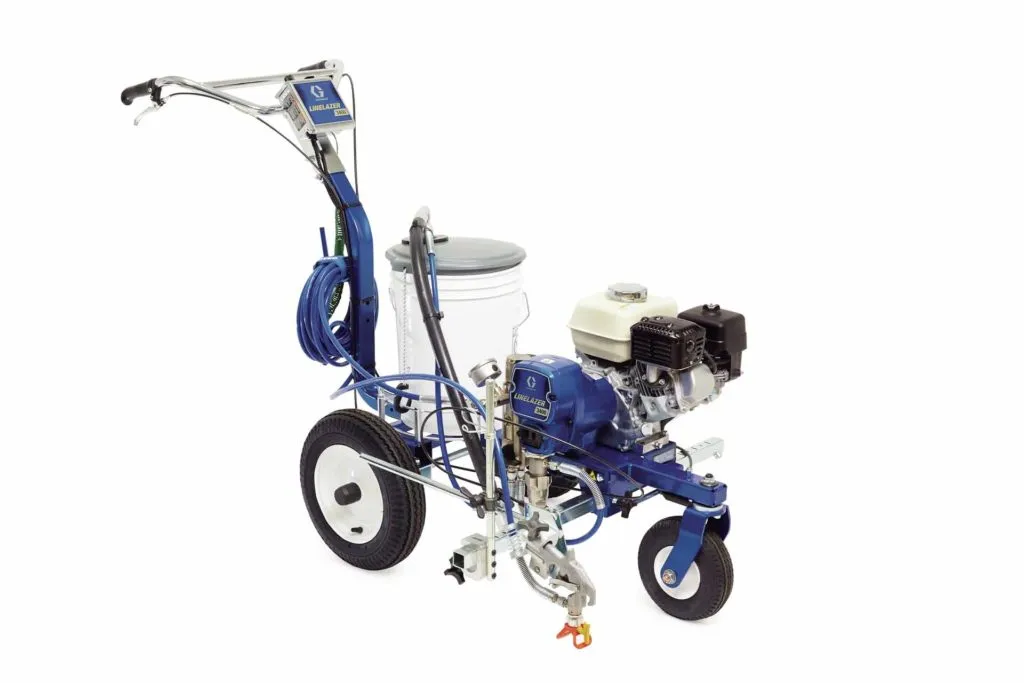- 6001 Elvas Ave, Sacramento
- (916) 451-5176

Painting a house is a big project, whether you’re tackling interior walls, exterior surfaces, or detailed cabinetry. A house painting machine, also known as a paint sprayer, can make this task much easier and more efficient. But with so many options available—airless paint sprayers, HVLP sprayer, spray guns, and more—it can be overwhelming to choose the right tool for your needs. In this guide, Capitol Barricade will break down everything you need to know about house painting machines, their various features, and how to select the best one for your project.
A house painting machine is a tool designed to spray paint onto surfaces quickly and evenly. Unlike traditional brushes or rollers, paint sprayers can cover large areas in a fraction of the time, providing a smooth and professional finish. These machines are versatile and can be used on various surfaces, including walls, fences, doors, cabinets, and even furniture.
When choosing a house painting machine, it’s essential to consider the key features that will impact your painting experience. Here are some of the most important aspects to keep in mind:
1. Adjustable Pressure Control: This feature allows you to control the amount of paint being sprayed, ensuring you can achieve the right consistency for different surfaces. Whether you’re painting exterior walls or intricate details, adjustable pressure control gives you the flexibility to do it all.
2. Tip Size and Spray Patterns: The tip size of your spray gun determines the spray pattern, which can be adjusted to suit different surfaces. Larger tips are ideal for broad surfaces like walls, while smaller tips provide precision for detailed work on furniture or cabinets.
3. Power Source: Paint sprayers can be powered by electricity, compressed air, or even handheld batteries. The power source will affect the machine’s portability, more power capabilities, and ease of use. Electric sprayers are common for home improvement projects, while air compressors provide consistent pressure for professional jobs.
4. Durability and Materials: Look for machines with durable construction, including copper nozzles and high-quality materials, to ensure longevity. A well-built sprayer can handle a variety of coatings, including thick paints and primers.
There are several types of paint sprayers, each with its strengths and weaknesses. Understanding the differences between them will help you choose the right one for your project.
Airless paint sprayers are the go-to choice for professional painters and contractors. They work by pumping paint at high pressure through a spray gun, producing a fine mist that coats surfaces evenly. Airless paint sprayers are ideal for large-scale projects like exterior walls, fences, and decks, offering more power and efficiency than other sprayers.
– Advantages: Fast application, suitable for thick paints, no need for compressed air.
– Disadvantages: Can produce overspray, requires careful setup and cleanup.
High Volume Low Pressure (HVLP) sprayers use a lower pressure to apply paint, resulting in a more controlled spray. These sprayers are perfect for detailed work like cabinets, doors, and furniture, where precision and a high-quality finish are essential.
– Advantages: Precise control, reduced overspray, great for small jobs and indoor use.
– Disadvantages: Slower than airless sprayers, may struggle with thicker paints.
Compressed air sprayers use an air compressor to atomize the paint, creating a smooth and even finish. These sprayers are versatile and can handle a wide range of paints and coatings, making them a popular choice for both professional and DIY projects.
– Advantages: Smooth finish, suitable for various materials, adjustable settings.
– Disadvantages: Requires an air compressor, more setup time, potential for overspray.
Electric handheld sprayers are compact, portable, and easy to use. They’re perfect for small jobs, touch-ups, and projects that require quick and convenient application. These sprayers often come with adjustable settings, making them versatile tools for a variety of tasks.
– Advantages: Portable, easy to use, great for small areas.
– Disadvantages: Limited power, may not be suitable for large projects or thick paints.
The spray gun and nozzle are critical components of any house painting machine. The right combination will ensure you achieve the desired spray patterns and coverage for your project.
The nozzle size you choose will affect the width and pattern of the spray. For broad surfaces like walls and fences, a larger nozzle (such as 517 or 619) is ideal. For more detailed work, such as painting cabinets or furniture, a smaller nozzle (like 311 or 413) provides the precision you need.
Copper nozzles are known for their durability and precision. They resist wear and tear better than other materials, making them a reliable choice for professional painters who need consistent, high-quality results.
Having the ability to adjust the pressure on your spray gun is essential for achieving a smooth, even finish on various surfaces. Lower pressure is ideal for delicate work, while higher pressure can quickly cover large areas.
Overspray occurs when paint particles spread beyond the intended surface, wasting paint and creating a mess. To minimize overspray, choose a sprayer with adjustable pressure control and select the appropriate tip size for the job. Additionally, practice on a scrap surface to fine-tune your technique before starting your project.
House painting machines are versatile tools that can be used on a wide range of surfaces, including walls, fences, doors, cabinets, and furniture. However, different surfaces may require different spray patterns and pressure settings. For example, exterior walls may need a broader spray pattern, while cabinets require a more focused spray for precision.
Most paint sprayers can handle a variety of paints, including latex, enamel, and oil-based paints. However, it’s essential to check the manufacturer’s recommendations for your specific sprayer. Thicker paints may need to be thinned before use, and some sprayers are better suited for certain types of coatings.
Regular maintenance is crucial for keeping your paint sprayer in good working condition. After each use, clean the spray gun, nozzle, and other components thoroughly to prevent paint buildup. If your sprayer uses an air compressor, check the air filter and oil levels regularly. Proper storage, including keeping the sprayer in a cool, dry place, will also extend its lifespan.

Whether you’re a seasoned contractor or a DIY enthusiast, these tips will help you achieve a smooth, professional finish with your house painting machine:
1. Prep the Surface: Clean and sand the surface to remove any dirt, grease, or imperfections. A well-prepared surface ensures better paint adhesion and a high-quality finish.
2. Test the Sprayer: Before starting, test the sprayer on a scrap piece of material. Adjust the pressure and spray pattern as needed to achieve the desired results.
3. Use Even Strokes: Keep the spray gun at a consistent distance from the surface and move it in even, overlapping strokes. This technique prevents streaks and ensures uniform coverage.
4. Watch for Drips: Be mindful of drips and runs, especially when working on vertical surfaces like walls. If you notice drips, stop and smooth them out with a brush or roller before continuing.
5. Layer Thin Coats: Applying multiple thin coats of paint rather than one thick coat results in a smoother, more durable finish. Allow each coat to dry thoroughly before applying the next.
Graco is a leading brand in the paint sprayer industry, known for its high-quality, durable equipment. Professional painters often choose Graco model sprayers for their reliability, precision, and ability to handle various projects, from large exterior walls to detailed cabinetry. Graco’s range of airless paint sprayer, in particular, offers features like adjustable pressure control, copper nozzles, and durable construction, making them a top choice for traffic control, contractors and serious DIYers alike.
As homeowners, a house painting machine is an invaluable tool for any painting project, offering speed, efficiency, and a professional finish. Whether you’re painting walls, fences, doors, or furniture, choosing the right paint sprayer, understanding its features, and mastering the proper techniques will make all the difference in the final result. With the right equipment and a little practice, you’ll be well on your way to achieving beautiful, long-lasting results on any surface.
By investing in a high-quality paint sprayer and following the tips and advice in this guide, you’ll not only save time and effort but also elevate the quality of your home improvement projects. Happy painting!